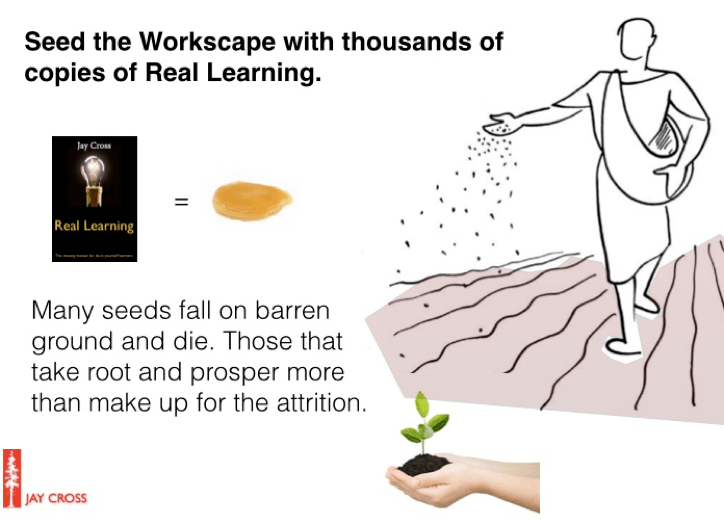Real Learning In Organizations: Bottom-Up Learning From The Top Down
For years, I’ve grappled with consultants who find it cute to say that we need to formalize informal learning. Snicker, snicker.
The joke is that if you formalize informal learning, you strip it of its anytime, anywhere, moment-of-need, spontaneous delivery and peel off the intrinsic motivation inherent in “I’m learning what I choose”.
What the smart-mouth critics mean to say is that it’s a good idea to routinize informal learning, to understand its value and how it works, and to nourish a culture that is fertile, open, sharing, experimental, networked, optimistic, and respects the opinions and value of others.
You nurture social learning; you don’t command that it happen. You might as well try to change the course of rivers by giving them orders and blowing upstream as demanding that people learn. Man plans; God laughs.
Research by Richard Boyatzis at the Wetherhill School of Management [1] found that no matter what else, adults learn what they want to learn. Boyatzis’s studies included studying for exams or being physically threatened; you don’t retain things you’re not interested in learning.
Dilemma For Organizations: Us Vs Them
How can we synchronize individual desires and organizational requirements?
People are inherently free spirits, acting in the secret movies playing in their minds.
This makes traditional managers squirm. They seek to get everyone lined up and assigned with their tasks, but the workforce is 30% to 90% unengaged, up yours, and resents lining up for anybody. Workers are no longer emotionless mechanical parts.
Match this against volatile, unpredictable demands from customers and rapidly morphing business models. We don’t even know what we’ll need to deliver a few years hence. How will factors like plain English results from Big Data, cheap answers from Watson (HAL), and intrusive bio-monitors change the picture?
People have to be organized, but in a traditional organization this leaves the manager herding cats. Square-peg people are hammered into round-hole job descriptions. Nobody is happy. The whole set up is wrong.
Organizations Are Organisms
The industrial age model of the organization as a machine has outworn its usefulness.
Networks changed everything. We're all connected, and nothing is ever finished. Old authority has given way to individual autonomy – you play by new rules or drop out of the game. Real time replaces calendar time. Free-flowing networks subvert hierarchy, markets become conversations, honest conversation drives out hype, and power flows to customers. Old style hierarchies and rigid organizational structures can’t keep up with today’s demands.
Organizations today are living organisms.
Responsive organizations perform like schools of minnows, not whales. Ecology replaces bureaucracy. Members replace employees. Caring human beings replace mechanical jobholders. Everyone acts in the organization’s interest, for it’s their interest, tool.
Thus, the secret to herding cats doesn’t lie at the individual cat level. You can’t spread yourself that thin. You must set up an environment that enables the cats to take care of themselves. You do things that benefit all the cats, e.g. an exercise program, more catnip, yoga classes. Or, if the cats are human, by helping them learn.
Organizations should strive to become as adaptable as a school of fish.
Every fish in the school is autonomous. I flip a chunk of pita from my seaside seat in the marina of Češme, Turkey. The fish arrive as one and then break ranks for a feeding frenzy.
Human behavior can be that way. On Black Friday, shoppers wait for hours for Macy’s or BestBuy to open its doors. Everyone is friendly, sharing hot tea and stories in the waiting line. Kumbaya. The doors open and pandemonium breaks out. Shoppers belligerently grab and shove as if they were poor farmers from the Steppes set loose with unlimited credit at a Whole Foods superstore. Confusion. Chaos. Then back to heading the same way, in formation, relaxed, poised, calm. They don’t follow a leader, but they all head in the same direction.
Responsibility is shifting from organization to individual. Everyone makes decisions on the spot. Organizational members help customers help themselves. We are each responsible for our own development. People concentrate on problem solving and customer service because the linear, repetitive, boring functions that people used to do back in the twentieth century are being delegated to computers.
All of us are smarter than any of us, so it’s wise to let the organization’s collective intelligence take the helm.
Organizations Are Alive
Three years ago, twenty one management theorists and agile coaches met on a mountaintop in Switzerland to discuss the need for organizational transformation. [3] The mountaintop summit echoed the famous mountaintop meeting that developed the Manifesto for Agile Software Development a dozen years earlier. We agreed that:
Reflecting on leadership in organizations today, we find ourselves in a bit of a mess. We see reliance on linear, mechanistic thinking, companies focusing more on stock price than delighting customers, and knowledge workers whose voices are ignored by the bosses who direct them. All these factors are reflected in the current economic crisis, increased inequity, bankruptcies and widespread disillusionment.
Our primary conclusion was that organizations should be seen as learning networks of individuals, and that management’s job is stewardship, not control.
We believe that we uncovered some of the common characteristics of that better way. For example, that organizations can become learning networks of individuals creating value and that the role of leaders should include the stewardship of the living rather than the management of the machine.
After the two-day session in Stoos, I took the train south to Lugano, a perennially sunny town that couples Swiss efficiency and Italian verve (Mangiare!) on the shore of an Alpine lake. Fragments of the mountain top conversations rolled around in my head. I concluded:
The business world must shift its focus from things to people. Living things trump machines. Moreover, people are inherently social. We cannot thrive -or even survive- in isolation. Connections are vital to creating value. And how is that value created? By adapting to change - and that requires learning. Bottom line: Businesses are networks of learning individuals.
Financial success is not the ultimate target. Chasing money for its own sake is wrong headed and demoralizing. Drucker had it right: The purpose of business is to create and satisfy customers. People in sustainable organizations focus on doing this better and better, forever delivering more value to their customers. Do this right and the money will follow.
For several hundred years, the machine has been the metaphor for the organization. Management’s role was to make the machine work efficiently. People were cogs; managers controlled human resources as if they were interchangeable parts. Bosses did the thinking; workers were told to get the job done. It was as if workers lacked intelligence, emotion, and initiative. Shut up and do your job.
Machines work well when you need to do the same thing over and over. They’re not so hot when doing different things is required. Denser interconnections have transformed the world into one vast complex system. The past is no longer a guide to the future. Small things have enormous consequences. Logic breaks down. Shit happens. Everything’s different.
These days it’s more productive to think of organizations as organisms. Managers become stewards of the living. Their role is to energize people, empower teams, foster continuous improvement, develop competence, leverage collective knowledge, coach workers, encourage collaboration, remove barriers to progress, and get rid of obsolete practices.
Living systems thrive on values that go far beyond the machine era’s dogged pursuit of efficiency through control. Living systems are networks. Optimal networks run on such values as respect for people, trust, continuous learning, transparency, openness, engagement, integrity, and meaning.
Transforming The Organization With Real Learning
Many businesses are in the process of transformation from top to bottom. They want to reinvent themselves as a social business or be digitally transformed or to adopt Management 2.0 or become a Learning Organization. Some are embracing radical management or management 3.0 or elastic leadership or customer capitalism or organic business. [4]
All of these approaches to transformation involve building a culture that is open, authentic, sharing, customer focused, social, risk tolerant, and progressive, the same values that are built into Real Learning.
An organization is moving from a traditional structure to an organic one is in an ideal position to embed real learning and working smarter into its culture.
| Traditional Structure Rigid Predictable Fixed Simple Absolute Linear Transactions Individuals Isolated One time Mass production Central authority Teacher-focused training |
Organic Structure Flexible Chaotic Flowing Complex Relative Linked Relationships Teams In context Iterative Mass customization Distributed intelligence Learner-focused learning |
Real Learning can ride on the coattails of an organization wide transformation. For a large effort, it’s worthwhile to customize the content of the book and website to focus on the change initiative. People will be learning to learn by learning more about their own organizations and teams. The usual change management advice applies: Get top management support, sell the stakeholders, enlist champions to proselytize, don’t try to boil the ocean.
Jane Hart’s Modern Workplace Learning [5] calls collaboration specialists and community managers to enable and support informal learning and collaboration. Learning and performance advisors assist with personal development. Once again, Real Learning can be a resource for helping people learn to learn.
The agricultural approach. Many executives and Chief Learning Officers buy into the philosophy underlying Real Learning and want to do something about it but lack a methodology and have scant time to devote to it. For them, I propose a radical approach. Treat the inexpensive Real Learning book and exercises as seeds. Distribute them widely.
Picture what I’m describing. I call the place where people work and learn a Workscape. Others call it a learning ecosystem. It’s the place where value is created.
Endnotes:
[1] See https://www.google.com/webhp?sourceid=chrome-instant&ion=1&espv=2&ie=UTF-8#q=formalize%20informal%20learning for discussions of formalizing informal learning.
[2] Richard Boyatzis, “Unleashing the Power of Self-Directed Learning,” advance chapter from Changing the Way We Manage Change: The Consultants Speak. (Quorum, 2002).
[3] Steve Dunning, “Stoss: Facilitating a Tipping Point for Organizations,” Forbes, January 13, 2012.
[4] Steve Denning, Comparison of Approaches to Transforming Management, Draft paper, January 2012.
[5] Jane Hart, Modern Workplace Learning, January 2015.













